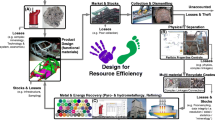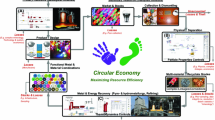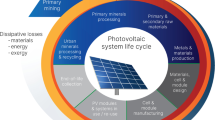Abstract
The second law of thermodynamics (2LT) helps to quantify the limits as well as the resource efficiency of the circular economy (CE) in the transformation of resources, which include materials, energy, or water, into products and residues, some of which will be irreversibly lost. Furthermore, material and energy losses will also occur, as well as the residues and emissions that are generated have an environmental impact. Identifying the limits of circularity of large-scale CE systems, i.e., flowsheets, is necessary to understand the viability of the CE. With this deeper understanding, the full social, environmental, and economic sustainability can be explored. Exergy dissipation, a measure of resource consumption, material recoveries, and environmental impact indicators together provide a quantitative basis for designing a resource-efficient CE system. Unique and very large simulation models, linking up to 223 detailed modeled unit operations, over 860 flows and 30 elements, and all associated compounds, apply this thermoeconomic (exergy-based) methodology showing (i) the resource efficiency limits, in terms of material losses and exergy dissipation of the CdTe photovoltaic (PV) module CE system (i.e., from ore to metal production, PV module production, and end-of-life recycling of the original metal into the system again) and (ii) the analysis of the zinc processing subsystem of the CdTe PV system, for which the material recovery, resource consumption, and environmental impacts of different processing routes were evaluated, and the most resource-efficient alternative to minimize the residue production during zinc production was selected. This study also quantifies the key role that metallurgy plays in enabling sustainability. Therefore, it highlights the criticality of the metallurgical infrastructure to the CE, above and beyond simply focusing on the criticality of the elements.
















Similar content being viewed by others
References
United Nations, Department of Economic and Social Affairs, Population Division (2017) World population prospects the 2017 revision, key findings and advance tables. Working paper no. ESA/P/WP/248. (Online). https://population.un.org/wpp/Publications/Files/WPP2017_KeyFindings.pdf. Accessed 15 July 2019
Ekins P et al (2017) Resource efficiency: potential and economic implications. A report of the International Resource Panel (UNEP). (Online). http://www.resourcepanel.org/sites/default/files/documents/document/media/resource_efficiency_report_march_2017_web_res.pdf. Accessed 16 Jun 2019
IPCC (2014) Climate change 2014: synthesis report. Contribution of working groups I, II and III to the fifth assessment report of the intergovernmental panel on climate change. IPCC, Geneva. (Online). https://www.ipcc.ch/site/assets/uploads/2018/05/SYR_AR5_FINAL_full_wcover.pdf. Accessed 15 July 2019
Valero A, Valero A, Calvo G, Ortego A (2018) Material bottlenecks in the future development of green technologies. Renew Sustain Energy Rev 93:178–200
Ali SH et al (2017) Mineral supply for sustainable development requires resource governance. Nature 543(7645):367–372
Månberger A, Stenqvist B (2018) Global metal flows in the renewable energy transition: exploring the effects of substitutes, technological mix and development. Energy Policy 119(April):226–241
Grandell L, Lehtilä A, Kivinen M, Koljonen T, Kihlman S, Lauri LS (2017) Role of critical metals in the future markets of clean energy technologies. Renew Energy 95:53–62
Moreau V, Dos Reis P, Vuille F (2019) Enough metals? Resource constraints to supply a fully renewable energy system. Resources 8(1):29
Reuter MA, van Schaik A, Gutzmer J, Bartie N, Abadías Llamas A (2019) Challenges of the circular economy—a metallurgical and product design perspective. Annu Rev Mater Res 49:10.1–10.22
Schulte-Schrepping K-H, Piscator M (2005) Cadmium and cadmium compounds. In: Ullmann’s Encyclopedia of Industrial Chemistry, vol 100C, Wiley, Hoboken
Knockaert G (2005) Tellurium and tellurium compounds. In: Ullmann’s encyclopedia of industrial chemistry. Wiley, Hoboken
European Parliament and Council (2012) Directive 2012/19/EU on waste electrical and electronic equipment (WEEE). Official Journal of the European Union. (Online). https://eur-lex.europa.eu/LexUriServ/LexUriServ.do?uri=OJ:L:2012:197:0038:0071:en:PDF. Accessed 11 July 2019
Reuter MA, Hudson C, van Schaik A, Heiskanen K, Meskers C, Hagelüken C (2013) Metal recycling: opportunities, limits, infrastructure. United Nations Environmental Protection (UNEP) Report. (Online). http://www.resourcepanel.org/reports/metal-recycling. Accessed 26 July 2018
United Nations (2015) Transforming our world: the 2030 agenda for sustainable development. Working Paper No. A/RES/70/1. (Online). https://sustainabledevelopment.un.org/content/documents/21252030%20Agenda%20for%20Sustainable%20Development%20web.pdf. Accessed 15 July 2019
World Commission on Environment and Development (1987) Our Common Future”. Oxford University Press, Oxford
Kates RW, Parris TM, Leiserowitz A (2005) What is sustainable development? Goals, indicators, values, and practice. Environment 47(3):8–21
Purvis B, Mao Y, Robinson D (2019) Three pillars of sustainability: in search of conceptual origins. Sustain Sci 14(3):681–695
Barbier EB (1987) The concept of sustainable economic development. Environ Conserv 14(2):101–110
Sinclair RJ (2005) The extractive metallurgy of zinc, vol 13. The Australasian Institute of Mining and Metallurgy, Melbourne
Hoang J, Reuter MA, Matusewicz R, Hughes S, Piret N (2009) Top submerged lance direct zinc smelting. Miner Eng 22(9–10):742–751
Creedy S, Glinin A, Matusewicz R, Hughes S, Reuter MA (2013) Outotec® Ausmelt technology for treating zinc residues. World Metall Erzmetall 66(4):230–235
Reuter MA (2016) Digitalizing the circular economy: circular economy engineering defined by the metallurgical internet of things. Metall Mater Trans B 47(6):3194–3220
Reuter MA, van Schaik A, Gediga J (2015) Simulation-based design for resource efficiency of metal production and recycling systems: Cases—copper production and recycling, e-waste (LED lamps) and nickel pig iron. Int J Life Cycle Assess 20(5):671–693
Reuter MA, Verhoef EV (2004) A dynamic model for the assessment of the replacement of lead in solders. J Electron Mater 33(12):1567–1580
Outotec, “HSC Chemistry 9,” 2019. (Online). https://www.outotec.com/. Accessed 28 Feb 2019
van Schaik A, Reuter MA (2016) Recycling indices visualizing the performance of the circular economy. World Metall Erzmetall 69(4):201–216
Reuter MA, van Schaik A, Ballester M (2018) Limits of circular economy: fairphone modular design pushing the limits. World Metall Erzmetall 71(2):68–79
Valero A, Lozano M, Munoz M (1986) A general theory of exergy saving I. On the exergetic cost. ASME. Adv Energy Syst Div 2:1–8
Tsatsaronis G (1993) Thermoeconomic analysis and optimization of energy systems. Prog Energy Combust Sci 19(3):227–257
Lozano MA, Valero A (1993) Theory of the exergetic cost. Energy 18(9):939–960
Valero AA, Usón S, Torres C, Valero AA, Agudelo A, Costa J (2013) Thermoeconomic tools for the analysis of eco-industrial parks. Energy 62:62–72
Usón S, Valero A, Agudelo A (2012) Thermoeconomics and industrial symbiosis. effect of by-product integration in cost assessment. Energy 45(1):43–51
Valero A, Usón S, Torres C, Valero A (2010) Application of thermoeconomics to industrial ecology. Entropy 12(3):591–612
Connelly L, Koshland CP (2002) Exergy and industrial ecology. Part 2: a non-dimensional analysis of means to reduce resource depletion. Exergy Int J 1(4):234–255
Szargut J, Morris D, Steward F (1988) Exergy analysis of thermal, chemical and metallurgical processes. Hemisphere Publishing Corporation, New York
Dewulf JP, Van Langenhove HR (2002) Quantitative assessment of solid waste treatment systems in the industrial ecology perspective by exergy analysis. Environ Sci Technol 36(5):1130–1135
Ayres RU (1998) Eco-thermodynamics: economics and the second law. Ecol Econ 26(2):189–209
Dewulf J, Van Langenhove H, Van De Velde B (2005) Exergy-based efficiency and renewability assessment of biofuel production. Environ Sci Technol 39(10):3878–3882
Valero A, Lozano MA, Serra L, Torres C (1994) Application of the exergetic cost theory to the CGAM problem. Energy 19(3):365–381
Wall G (1988) Exergy flows in industrial processes. Energy 13(2):197–208
Hernandez AG, Cullen JM (2016) Unlocking plant-level resource efficiency options: a unified exergy measure. Procedia CIRP 48:122–127
Castro MBG, Remmerswaal JAM, Brezet JC, Reuter MA (2007) Exergy losses during recycling and the resource efficiency of product systems. Resour Conserv Recycl 52(2):219–233
Ignatenko O, van Schaik A, Reuter MA (2007) Exergy as a tool for evaluation of the resource efficiency of recycling systems. Miner Eng 20(9):862–874
Ayres RU, Ayres LW, Masini A (2006) An application of exergy accounting to five basic metal industries. Sustainable metals management: securing our future—steps towards a closed loop economy. Springer, New York, pp 141–194
Abadías Llamas A et al (2019) Simulation-based exergy, thermo-economic and environmental footprint analysis of primary copper production. Miner Eng 131:51–65
Szargut J (1989) Chemical exergies of the elements. Appl Energy 32(4):269–286
Thinkstep (2019) GaBi LCA software. (Online). https://www.thinkstep.com/. Accessed 28 Feb 2019
Graf GG (2005) Zinc. Ullmann’s encyclopedia of industrial chemistry. Wiley, Hoboken, p 23
Schlesinger ME, King MJ, Sole KC, Davenport WG (2011) Extractive metallurgy of copper. Elsevier, Amsterdam
Lossin A (2005) Copper. Ullmann’s encyclopedia of industrial chemistry. Wiley, Hoboken, p 67
Sinclair RJ (2009) The extractive metallurgy of lead, vol 15. The Australasian Institute of Mining and Metallurgy, Melbourne
Sutherland CA, Milner EF, Kerby RC, Teindl H, Melin A, Bolt HM (2006) Lead. Ullmann’s Encyclopedia of Industrial Chemistry. Wiley, Hoboken, p 48
Bonnet D (2012) CdTe thin-film PV modules. Practical handbook of photovoltaics. Elsevier, Amsterdam, pp 283–322
Fthenakis VM (2004) Life cycle impact analysis of cadmium in CdTe PV production. Renew Sustain Energy Rev 8(4):303–334
Wang W, Fthenakis V (2004) Leaching of cadmium, tellurium and copper from cadmium telluride photovoltaic modules
Marwede M, Reller A (2012) Future recycling flows of tellurium from cadmium telluride photovoltaic waste. Resour Conserv Recycl 69:35–49
Krueger L (2010) Overview of first solar’s module collection and recycling program. Berlin
Sinha P, Cossette M, Ménard J-F (2012) End-of-life CdTe PV recycling with semiconductor refining. 27th European photovoltaic solar energy conference and exhibition, pp 4653–4656
Blanpain B, Reuter MA, Malfliet A (2019) Lead metallurgy is fundamental to the circular economy. SOCRATES Policy Brief. (Online). https://kuleuven.sim2.be/wp-content/uploads/2019/02/SOCRATES-Policy-Brief-2019-Lead.pdf. Accessed 16 June 2019
Wood J, Coveney J, Helin G, Xu L, Xincheng S (2015) The Outotec® direct zinc smelting process. Proc Pb-Zn 2015(2):537–548
Rämä M, Nurmi S, Jokilaakso A, Klemettinen L, Taskinen P, Salminen J (2018) Thermal processing of jarosite leach residue for a safe disposable slag and valuable metals recovery. Metals (Basel) 8(10):744
Lee GF, Jones-Lee A, Martin F (1994) Landfill NIMBY and systems engineering: a paradigm for urban planning. INCOSE Int Symp 4(1):924–931
Hsu S-H (2006) NIMBY opposition and solid waste incinerator siting in democratizing Taiwan. Soc Sci J 43(3):453–459
Moffat K, Zhang A (2014) The paths to social licence to operate: an integrative model explaining community acceptance of mining. Resour Policy 39(1):61–70
European Union (2018) DIRECTIVE (EU) 2018/851 OF THE EUROPEAN PARLIAMENT AND OF THE COUNCIL of 30 May 2018 amending Directive 2008/98/EC on waste. Official Journal of the European Union. (Online). https://eur-lex.europa.eu/legal-content/EN/TXT/PDF/?uri=CELEX:32018L0851&from=EN. Accessed 16 June 2019
Reuter MA, Eksteen JJ, Van Schaik A (2003) Pyrometallurgical reactors—closers of the recycling material cycle. In TMS annual meeting Yazawa international symposium on metallurgical and materials processing: principles and technologies, no 1, pp 1005–1018
Acknowledgements
This research has received funding from the European Commission’s H2020—Marie Sklodowska Curie Actions (MSCA)—Innovative Training Networks within SOCRATES (Website http://etn-socrates.eu) project under the Grant Agreement No. 721385. This work reflects only the author’s view, exempting the Community from any liability. The authors also acknowledge the reviewers for their comments that greatly improved the manuscript, especially also prompting the drawing of the revised Fig. 1, which now nicely reflects the inconvenient truth around the circular economy and captures succinctly the message of this paper.
Author information
Authors and Affiliations
Corresponding authors
Ethics declarations
Conflict of interest
On behalf of all authors, the corresponding author states that there is no conflict of interest.
Additional information
The contributing editor for this article was S. Kitamura.
Publisher's Note
Springer Nature remains neutral with regard to jurisdictional claims in published maps and institutional affiliations.
Appendix
Rights and permissions
About this article
Cite this article
Abadías Llamas, A., Bartie, N.J., Heibeck, M. et al. Simulation-Based Exergy Analysis of Large Circular Economy Systems: Zinc Production Coupled to CdTe Photovoltaic Module Life Cycle. J. Sustain. Metall. 6, 34–67 (2020). https://doi.org/10.1007/s40831-019-00255-5
Published:
Issue Date:
DOI: https://doi.org/10.1007/s40831-019-00255-5























